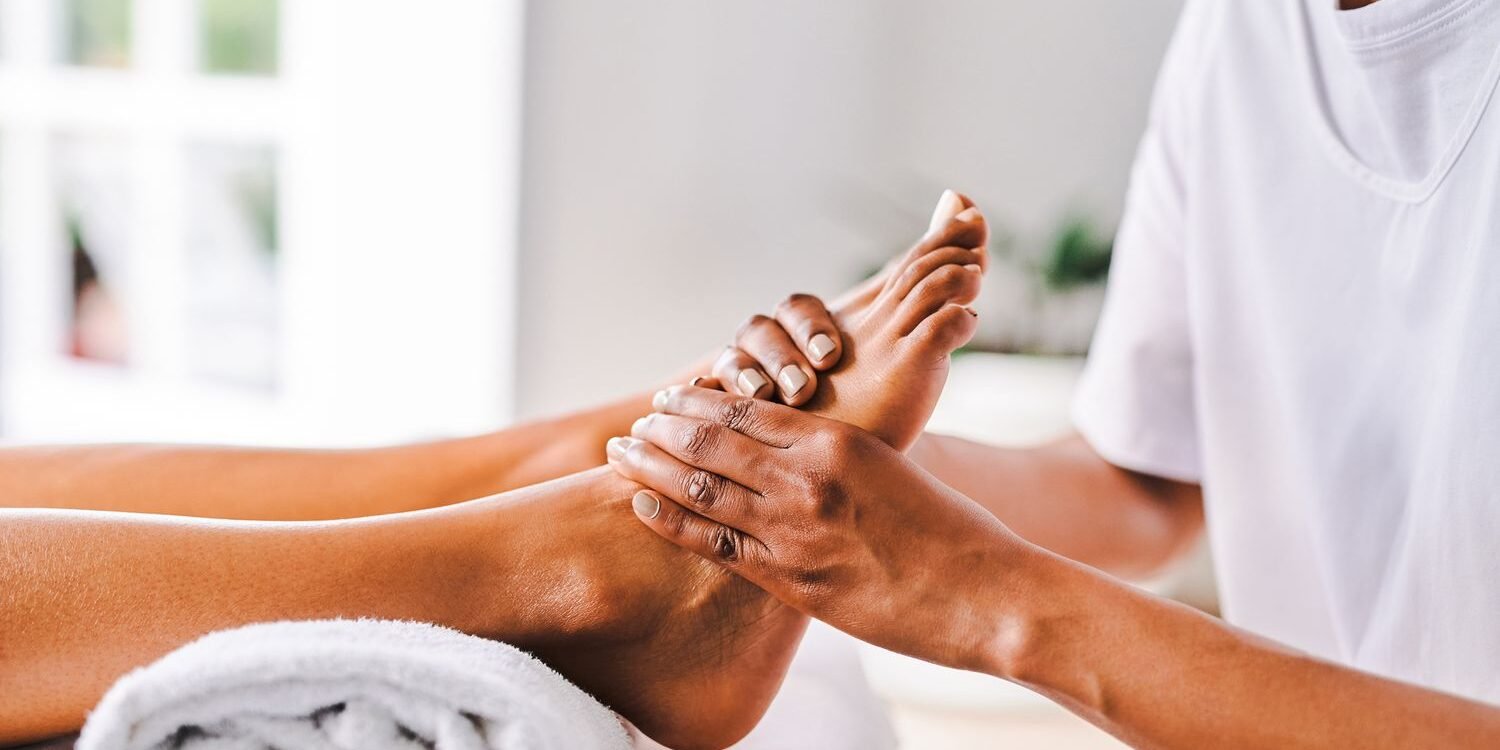Reflexology is a complementary therapy in which pressure is applied to specific areas—usually on the feet and hands but sometimes on the ears or face—said to correspond to all organs and systems in the body. The reflexologist thus believes that health is promoted in the related organs when an area is stimulated via an energetic pathway. While many find reflexology to be something that relaxes them and helps to reduce stress, there is limited scientific evidence of its efficacy for treating specific health conditions.
History of reflexology
While reflexology has its roots in ancient civilizations, the modern practice of reflexology is far removed from these historical traditions. A brief overview of the history of reflexology includes the following:
Ancient Civilizations: The earliest evidence of foot and hand therapy dates back to ancient Egypt, about 2330 BC. A pictograph found in the tomb of an Egyptian physician, Ankmahor, depicts individuals having treatments on their hands and feet. Traditions of pressure therapies also exist in ancient Chinese and Indian civilizations, precursors to reflexology and those now closely associated with acupressure and acupuncture.
Early 20th Century: The early 1900s saw the introduction of the modern version of reflexology to the Western world. An American ear, nose, and throat doctor, Dr. William Fitzgerald, developed the theory of “zone therapy”. He believed that the body was divided into ten vertical zones, and that applying pressure to a certain area in one of these zones could affect organs and other parts of the body within the same zone.
1930s: Eunice Ingham, a physical therapist, began developing and refining the work of Dr. Fitzgerald. She is often thought of as the “mother of modern reflexology”. Ingham mapped out reflex points on the feet and hands that corresponded to various organs and systems in the body. She established the techniques and methods that form the foundation of modern reflexology.
Later 20th Century: The early 1970s and 1980s saw the rise in popularity of reflexology, not only in the US but also worldwide. Schools were opened, and certification programs were developed to provide more structure to training and practice.
Today, reflexology is done all over the world and enjoys different levels of acceptance; in some places, it has been integrated into the mainstream healthcare system, while elsewhere it remains either a complementary or an alternative therapy. In these modern times, many organizations and associations exist that provide training for reflexologists and certify them before they start professional practice.
Where reflexology remains quite popular, scientific studies of this practice have come back with rather mixed findings. Though some studies indicate possibilities, most notably with regards to reducing stress and the induction of relaxation, many within the medical community want to see further, thorough research as the foundation for some form of substantiation on specific claims made in massage therapies.
What is foot reflexology?
The main specific type of reflexology includes working with the feet. This form of reflexology assumes that there are points in the feet corresponding to various organs, systems, and structures in the human body. Applying pressure to specific reflex points in the feet will result in inducing health and healing to those body parts.
Here is generally how foot reflexology is understood and practiced:
Reflex Points: A chart of foot reflexology delineates the areas in the feet that relate to different parts of the body. The tip of the big toe may be linked to the head, while the heel corresponds with the lower back or pelvic area.
Technique: Reflex points receive pressure applied by reflexologists using unique hand techniques including thumb and finger walking, hooking, and rotation.
Purpose: The main purposes of foot reflexology are to reduce stress, relax, and promote the well-being of a person. Some professionals even link it to solving different health problems, such as headaches, digestive problems, or hormonal disorders.
Session: In general, it usually takes 30-60 minutes for the customer to do the session in foot reflexology. The customer is usually seated or lying down in bed during that moment when reflexologists work on feet. Some might experience tingling or feeling warmth momentarily uncomfortable at any time. Precautions: Although most people can safely receive reflexology of the feet, not everyone can. For example, people with injuries or infections of the feet, or certain diseases, may be advised to avoid reflexology or receive approval from their medical doctor before getting a session. It is important to remember that, while for many individuals, foot reflexology is an effective and extremely soothing way of spending time in order to decrease levels of stress, evidence from a medical point of view to back up the treatment of specified health complaints is minimal. Specific health questions should always be discussed with a qualified healthcare professional.
What is hand reflexology?
Hand reflexology works on the principle of foot reflexology but in the hands. It is based upon the belief that the hands have reflex points matching to organs and systems of the body. Applying pressure to those points on hands, reflexologists believe stimulation of health and healing in the respective parts of the body could be promoted.
Here’s a quick overview of hand reflexology:
Reflex Points: A reflexology chart of the hand delineates those points on the hands believed to relate to different parts of the body. For example, the fingertips may be associated with the head while the root of the palm is said to be linked to the lower torso.
Technique: Reflexologists use different hand techniques like pressing, kneading, and rubbing to apply the stimulus on reflex points.
Purpose: The aims of hand reflexology are identical to those for foot reflexology: the dissipation of tension, the induction of relaxation, the improvement in general well-being, and the possible amelioration of specific health problems.
Session: Hand reflexology treatments can be variable in their length, although most sessions commonly last anywhere from 20 minutes to one hour. The client is seated and relaxed while their hands are presented to the reflexologist for treatment. Benefits: Hand reflexology may be most helpful for people who have disorders with their feet or who do not feel comfortable with manipulation of their feet. It’s also practical because it can be done almost anywhere, even at one’s desk or while traveling. Precautions: Just like in foot reflexology, there are also instances that hand reflexology is not advisable, like if a person has an injury or infection in the hands. It’s always better to consult a physician for any apprehensions about one’s health. While many find the practice of hand reflexology to be relaxing and helpful, one should not forget that scientific proof for its efficiency in certain health problems is scarce. It is best described as a complementary therapy, not a replacement for medical treatments.
What is ear reflexology?
Ear reflexology, also widely known as “auricular therapy,” is a form of alternative therapy that addresses the ears. As in foot and hand reflexology, it is also based on the principle that the ear contains reflexive points corresponding to different organs and systems of the body. The stimulation of these points is said to bring about healing and balance in the parts of the body to which they correspond.
Overview of ear reflexology:
Reflex Points A reflexology chart of the ear depicts an outline of reflex points located on the ear which are representative of various parts of the body along with its respective systems. The ear can be viewed essentially as a fetus turned inside out-the head of the fetus may be charted at the lowest middle portion of the ear while the feet can be tracked at the tip.
Technique: Reflexologists use small instruments, fingertips, or even special ear seeds-small seeds from the Vaccaria plant-to press or stimulate reflex points on the ear. Sometimes, small needles are used, and the practice resembles acupuncture, only that it is applied to the ear.
Purpose: It is believed by practitioners that the stimulation of reflex points on the ear can relieve pain, reduce stress, bring balance to the body, and even resolve specific health issues.
Session: Generally, ear reflexology sessions take a smaller amount of time than other areas such as on the feet or hands; however, session times do vary. The client is seated during their treatment by the reflexologist.
Benefits: Some seek ear reflexology to address specific problems, such as pain management, addictions, migraine problems, or even weight loss. Due to the compact nature of the ear, it is often a convenient focal area in reflexology, for quick sessions or as an adjunct to other treatments. Precautions: As is true with any variety of therapy, there are many circumstances under which it would not be advisable to administer ear reflexology, which would include ear infection and recent ear surgeries. Always check with a health professional before adding a new type of therapy. It is worth noting, however, that while symptomatic relief and relaxation through ear reflexology are found by many people, scientific evidence to support its specific therapeutic claims is limited. It should be approached as a complementary therapy and not a substitute for conventional medical treatments.
Difference between reflexology and acupressure
Whereas reflexology and acupressure are similar in that both alternative therapies apply pressure to various points on the body, the principles upon which they are based, as well as their origins and practice, differ. Here are the primary differences between the two:
Origins:
Reflexology: Even though it has its origins in ancient Egypt and China, the reflexology of the world today has evolved rather recently in the West.
Acupressure: This is a technique originating from the ancient Chinese several thousand years ago. It is closely related to acupuncture. The only difference is that, unlike acupuncture, it does not make use of needles but instead uses the hands, fingers, or any other tool to apply pressure.
Foundational Principles:
Reflexology: It is based on the belief that feet, hands, ears, and sometimes the face contain reflex points corresponding to different parts or organs of the body. In stimulating these, it is believed you can promote health and healing in the corresponding body parts.
Acupressure It essentially depends for its principles of operation on concepts of Traditional Chinese Medicine, precisely the concept generally referred to as Qi – life energy or chi. Techniques of acupressure take into consideration Qi harmonies by the stimulus of certain crucial points, more commonly known as acupoints, lying over meridians or energy conducts around in your body.
Technique:
Reflexology: The method of applying techniques that would Daven on the reflex points in the feet, hands, ears, or face. Acupressure: It is the finger, and in some cases instrumental, application on specific acupoints of the body.
Application Areas:
Reflexology: This primarily covers the feet and hands, although it also includes the ears and face.
Acupressure: Can be applied all over the body, wherever the acupoints are located.
Purpose:
In general, reflexology is supposed to relax, reduce stress, and promote the health and well-being of a person.
Acupressure generally involves the relief of pain, reduction of stress, smoothing the flow of energy, and treatment of certain conditions according to indications based on TCM principles.
Training:
Reflexology: Reflexologists are trained in their own particular discipline, learning about the reflex points and which part of the body they correspond to. Acupressure: Professionals study principles of Traditional Chinese Medicine on meridians, acupoints, and the flow of Qi. While both reflexology and acupressure are considered complementary therapies, and many people find them helpful, it is always advisable to consult a healthcare professional in matters involving health. Scientific evidence regarding their effectiveness may be limited, and they should not be regarded but as complementary to conventional medical treatments.







